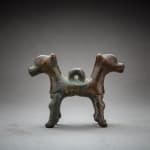Luristan Bronze Pendant, 1350 BCE - 650 BCE
Copper-Alloy
height 7 cm
height 2 3/4 in
height 2 3/4 in
LO.1043
Elegant bronze lost-wax pendant featuring two horse protomes back to back facing outward and joint at the belly, surmounted by a loop used for suspension. In the late 2nd millennium...
Elegant bronze lost-wax pendant featuring two horse protomes back to back facing outward and joint at the belly, surmounted by a loop used for suspension.
In the late 2nd millennium and early first millennium B.C., inhabitants of the mountainous region of western Iran, known as Luristan, manufactured an astonishing variety of bronze objects, including weapons, standards, jewelry, horse ornaments, and vessels, most of which have been recovered from cemeteries. The nature of the society and economy that produced these bronzes is not known with certainty but seems to have been predominantly nomadic.
Similar bronze pendants have been unearthed throughout the Luristan region and dated to the early 1st millennium BC. The explicit reference to the horse reflects once again the love and/or economic dependence of the Luristan people on the horse.
Reference: H. Mahboubian, The Art of Ancient Iran, 1998.
In the late 2nd millennium and early first millennium B.C., inhabitants of the mountainous region of western Iran, known as Luristan, manufactured an astonishing variety of bronze objects, including weapons, standards, jewelry, horse ornaments, and vessels, most of which have been recovered from cemeteries. The nature of the society and economy that produced these bronzes is not known with certainty but seems to have been predominantly nomadic.
Similar bronze pendants have been unearthed throughout the Luristan region and dated to the early 1st millennium BC. The explicit reference to the horse reflects once again the love and/or economic dependence of the Luristan people on the horse.
Reference: H. Mahboubian, The Art of Ancient Iran, 1998.



